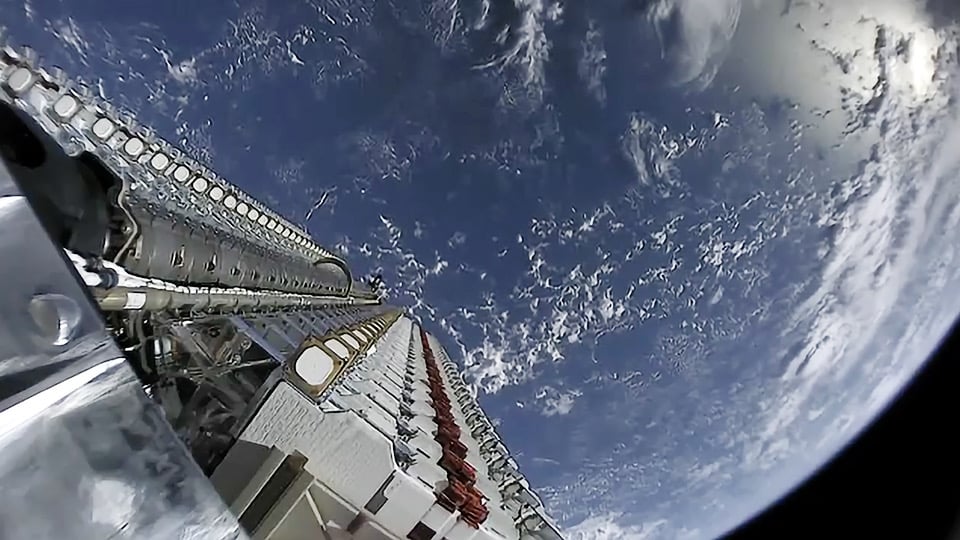Picture trying to listen to a whispered conversation while standing next to a construction site. That's essentially what radio astronomers face today as thousands of internet satellites flood Earth's orbit, accidentally jamming the faint signals used to unlock the secrets of the universe. A groundbreaking study from Curtin University reveals that the quest for global connectivity is creating an unexpected obstacle to our greatest scientific discoveries, from understanding dark matter to testing Einstein's theories.
The promise of high speed internet anywhere on Earth has led companies like SpaceX to launch massive satellite networks. Starlink, the largest constellation with over 7,000 satellites, beams internet to remote areas of the globe where traditional connections can't reach. But these same satellites are creating an unintended side effect that threatens one of science's most ambitious projects.
 Starlink Mission with satellites stacked together before deployment (Credit : SpaceX)
Starlink Mission with satellites stacked together before deployment (Credit : SpaceX)
Researchers from Curtin University conducted the world's biggest survey of low frequency satellite radio emissions, analyzing 76 million images of the sky using equipment designed for the Square Kilometre Array (SKA). What they found was troubling; more than 112,000 radio emissions from 1,806 Starlink satellites, with up to 30 percent of some datasets showing interference.
The problem isn't just the sheer number of satellites launching; 477 Starlink satellites were deployed during just the four month study period. The real issue is that satellites are leaking radio signals from their onboard electronics, creating interference that astronomers can't easily predict or filter out. Some satellites were detected emitting in frequencies that are supposed to be protected for radio astronomy, such as the 703 satellites identified at 150.8 MHz.
 Artist's impression of the 5km diameter central core of Square Kilometre Array (SKA) antennas (Credit : SPDO/TDP/DRAO/Swinburne Astronomy Productions)
Artist's impression of the 5km diameter central core of Square Kilometre Array (SKA) antennas (Credit : SPDO/TDP/DRAO/Swinburne Astronomy Productions)
Think of radio astronomy as cosmic archaeology. Radio telescopes detect incredibly faint signals from distant galaxies, black holes, and the remnants of the Big Bang itself. These signals have traveled billions of years through space, only to be overwhelmed by electronic noise from satellites orbiting just hundreds of miles above Earth.
PhD candidate Dylan Grigg, who led the study, explains that Starlink has become the most immediate and frequent source of potential interference for radio astronomy. The leaked emissions aren't intentional transmissions but rather electronic noise from components like power systems and processors making them unpredictable and difficult to avoid.
The timing couldn't be more critical. The SKA telescope, currently under construction, promises to help answer fundamental questions about how the first stars formed, the nature of dark matter, and even test Einstein's theories of relativity. But these discoveries require what researchers call "radio silence” a clear electromagnetic environment free from artificial interference.
 Radio studies of matter surrounding galaxies leads to simulated dark matter halo studies to unravel its mysteries.
Radio studies of matter surrounding galaxies leads to simulated dark matter halo studies to unravel its mysteries.
Professor Steven Tingay, who co-authored the study, emphasises that current international regulations focus on intentional transmissions and don't cover unintended emissions. Importantly, Starlink isn't violating any current rules and discussions with SpaceX have been constructive.
The challenge lies in finding balance. Global internet connectivity brings immense benefits, connecting remote communities to education, healthcare, and economic opportunities. But as we stand on the brink of revolutionary astronomical discoveries, scientists are calling for updated policies that consider the unintended consequences of our connected future. The solution isn't to stop progress but to ensure that our technological advancement doesn't accidentally close the door on understanding our cosmic origins.
Source : Interference to astronomy the unintended consequence of faster internet

